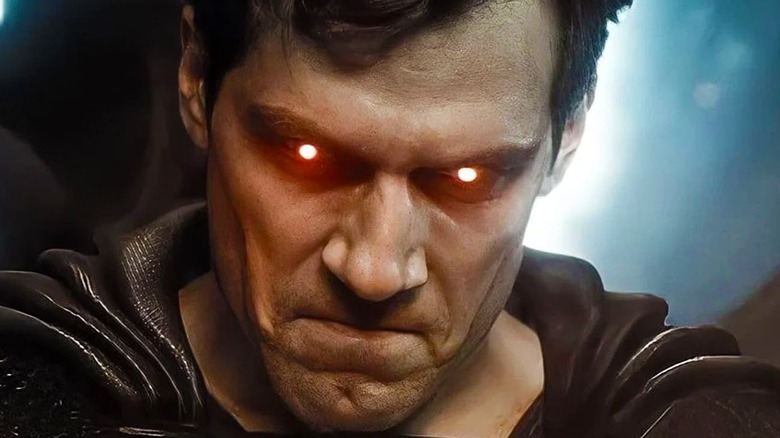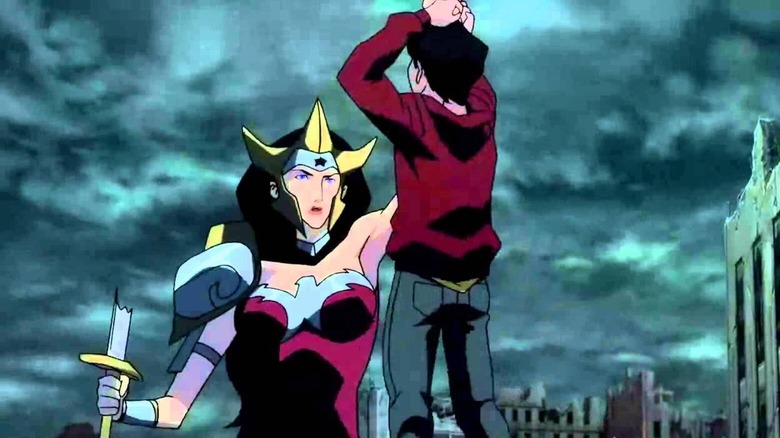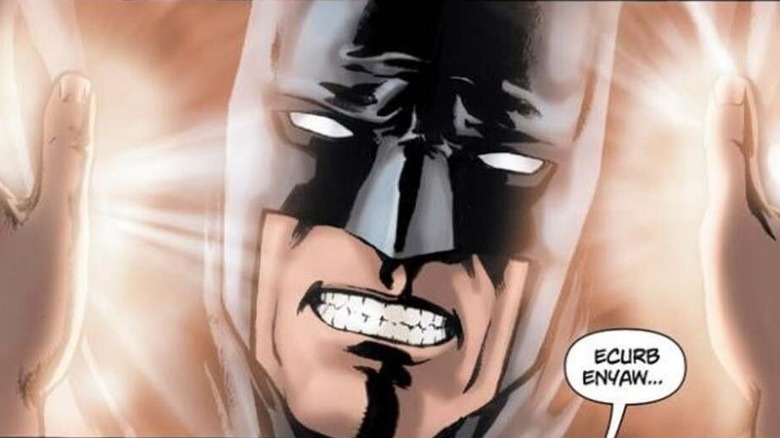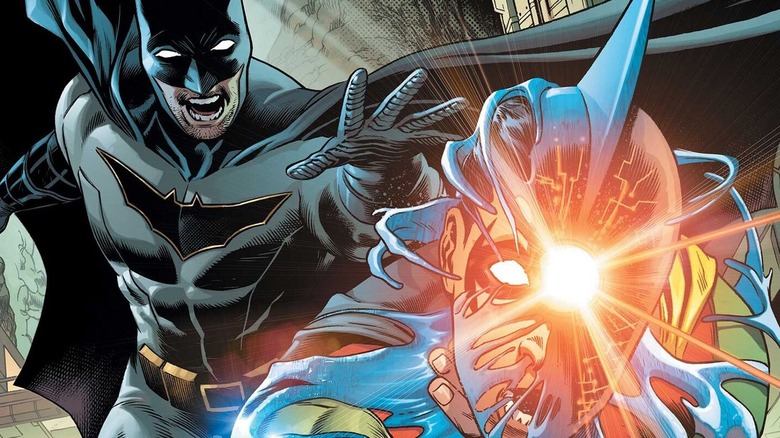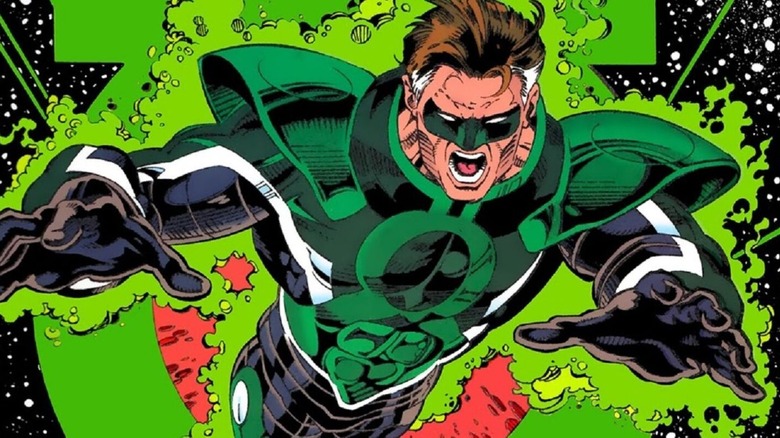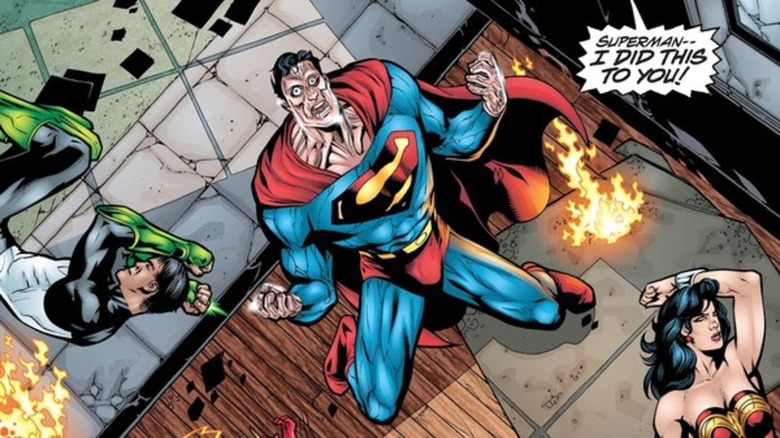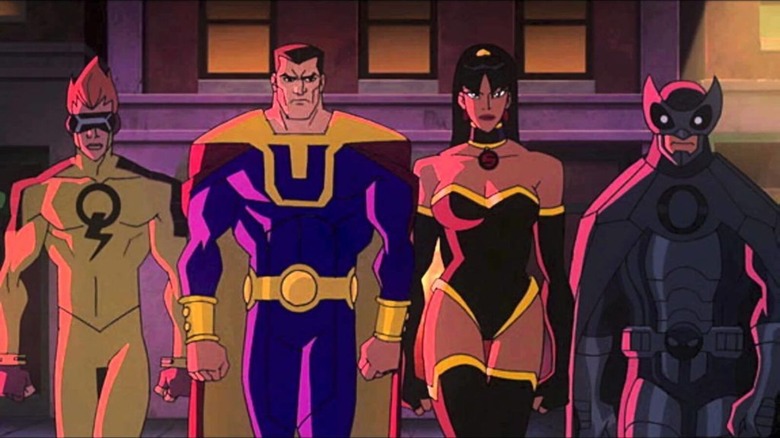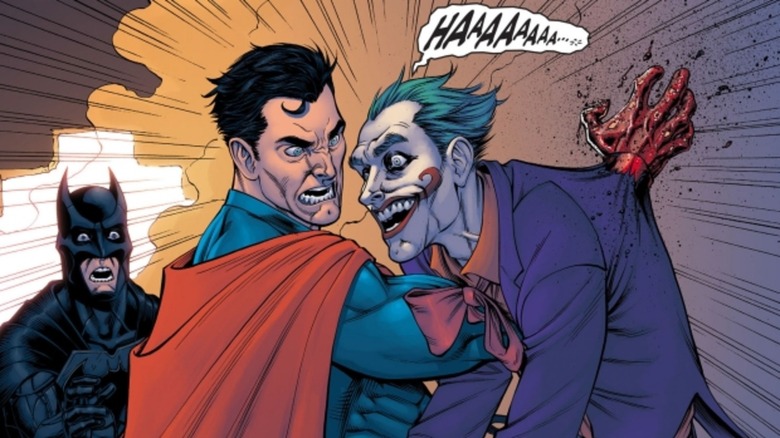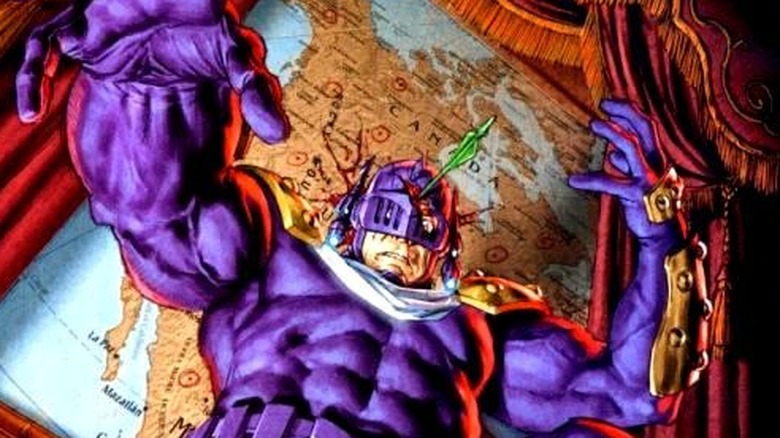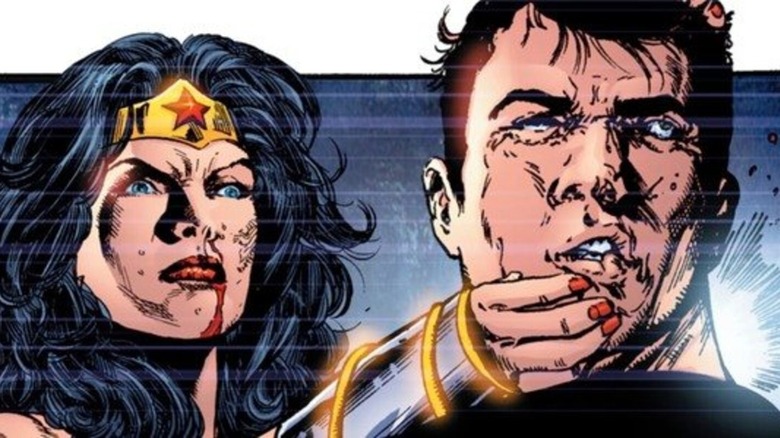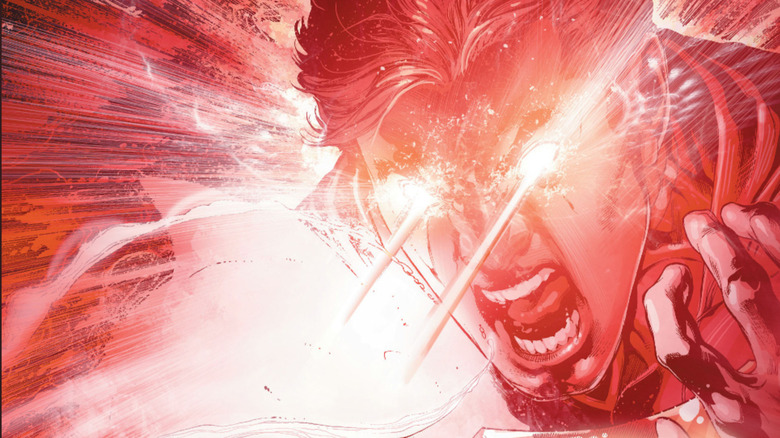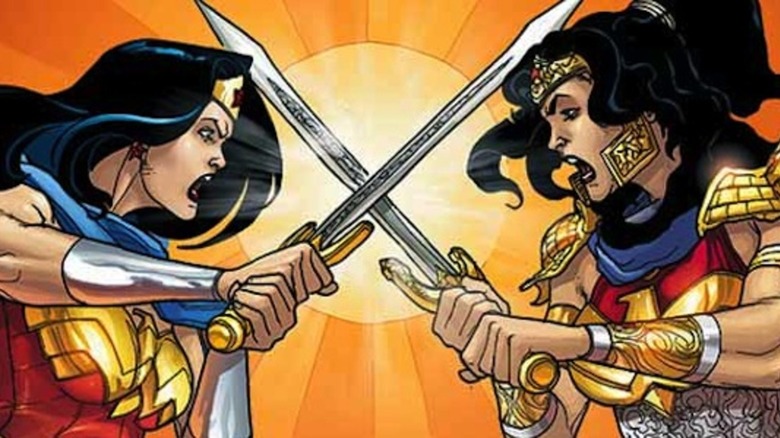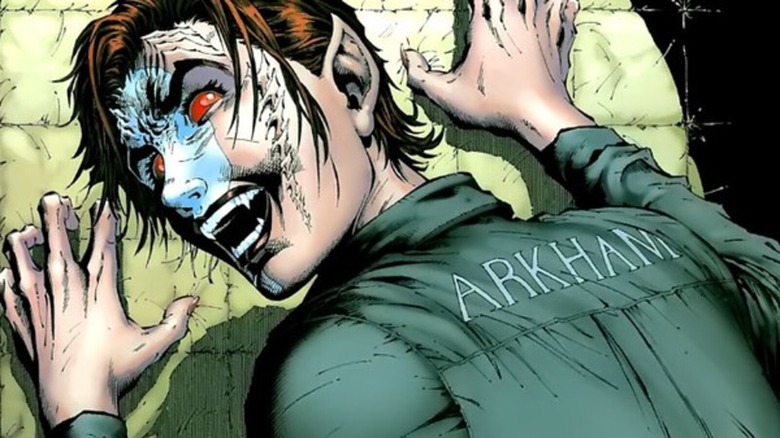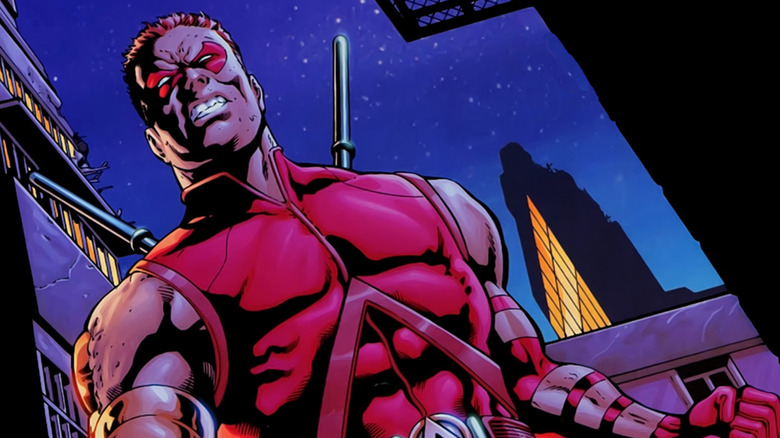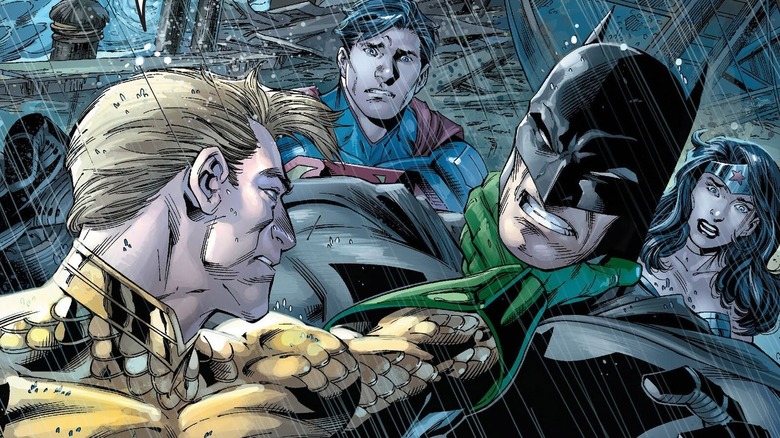The Dark History Of Justice League
The Avengers might be ruling the roost at the box-office these days, but true comic book aficionados know that there is one superhero team that stands above all else when it comes to the history and impact of the medium. That team is the Justice League of America, nowadays often shortened to simply the Justice League. The team features the greatest heroes ever created by DC Comics, coming together to save the world from all manners of threats.
Over the years, the Justice League has evolved in new and unexpected ways. Major characters have joined the team or left, seemingly at random. Imitation groups have sprung up that attempt to put a new twist on the dynamics established by the League. And other universes have been discovered in the DC Multiverse that carry their own versions of the Justice League, sometimes with dire results.
The history of the Justice League is not an entirely happy one. With so many powerful personalities working in close proximity, fighting to avert one catastrophe after another, there are naturally times when the League's existence has been more a cause of grief than celebration. Let's take a look at some of the most notably dark moments in the evolution of the League through the years.
The reboot that caused massive destruction
The scarlet speedster known as The Flash has been a part of DC Comics since making his fast-moving debut in 1959.
Most audiences know Flash as the guy who can move really fast. But true fans know that Flash's speed allows him to pull off feats of staggering power that even Superman cannot. Case in point, the 2011 "Flashpoint" comic series, which is possibly the most famous storyline regarding Flash ever written.
In the series, Barry Allen (aka Flash) wakes up to find the world dramatically altered, and not for the better. Although Barry's previously dead mother Nora is now alive, his father has been dead for three years. Superman is nowhere to be found, and the Justice League was never created. Batman is a bloodthirsty anti-hero, and Aquaman and Wonder Woman have formed rival factions that they use to brutally subjugate the planet.
At first, Barry thinks the new state of the world was caused by the villain Reverse-Flash. But it is eventually revealed that Barry himself caused the universe's reboot when he travelled back in time to prevent his mother's murder. After realizing everything that happened is his fault, Barry races to put things back the way they were. But not before the world had witnessed untold destruction and despair.
In 2017, it was announced that The Flash spin-off movie starring Ezra Miller was entitled "Flashpoint." That title has since reverted to "The Flash," but a significant segment of fans are undoubtedly still hoping major plot points from the comics will feature in the 2022 film's storyline.
Why Batman doesn't trust superheroes
Batman has always been famously suspicious of other superheroes. This trait has often been referred to as "paranoia" by the Dark Knight's detractors, since he remains distrustful of the heroes even after having fought alongside them so many times. But one particular incident served to illustrate just how justified Batman's suspicions are when it comes to metahumans.
In the comic series "Identity Crisis," it is revealed that the villain Doctor Light had once assaulted Sue Dibny, wife of Elongated Man, in the JLA satellite headquarters. To make sure such an incident never occurred again, the metahuman members of the League allowed Zatanna to mind-wipe Light and neutralize his criminal tendencies before sending him off to prison.
Batman came to learn of this secret decision as Zatanna was performing the mind-wipe. Enraged at the violation of Light's mind, Batman attacked the other members of the League. That was when the team put the final nail in the coffin with regards to Batman's paranoia — by mind-wiping him as well. Once Batman regained his memories, the trust between him and the other superheroes was irreparably broken.
When Batman endangered the entire planet
Batman has a very good reason for being suspicious of other heroes (see the example above). Unfortunately, those same suspicions have occasionally led the Dark Knight down some deadly paths. Like the time he created the Brother MK I satellite as a result of his deepened distrust of superheroes, following the regaining of his memories regarding the incident with Doctor Light.
The Brother MK I satellite was created with the sole purpose of gathering data on all metahumans, whether heroes or villains. Later, Maxwell Lord tinkered with the satellite's A.I., teaching it to fear and distrust all metahumans. After Lord died, Brother MK I renamed itself Brother Eye and initiated the "KingIsDead" protocol. Through this protocol, Brother Eye attacked all metahumans on Earth using the information it had gathered in all that time.
What was worse, the A.I. became a threat for the entire multiverse when it decided to aid Alexander Luthor Jr. in destroying the old universes in order to create a new, perfect world where there would no longer be a need for metahumans. Although Batman and the rest of the League were able to avert that catastrophe, they were not able to completely destroy Brother Eye. The rogue A.I. is shown to be a problem for the world far into the future.
Hal Jordan destroyed all the other Green Lanterns
Hal Jordan is considered one of the most legendary figures in all of DC Comics. There are many Green Lanterns in the universe, but Jordan's status as a Green Lantern has reached almost mythical levels over time. Despite the reverence with which the other Lanterns treat Jordan, he has a deeply checkered past, and has been responsible for horrific amounts of hurt and pain.
It all started in the "Emerald Twilight" arc with the destruction of Coast City, Jordan's former home, at the hands of the supervillain Mongul. Filled with grief and guilt over not being able to save the city's seven million inhabitants, Jordan attacked and brutally beat up Mongul. He then created a replica of Coast City using his ring. Due to his actions, Jordan was summoned to the planet Oa before the Guardians, who guard the power battery that supplies energy to all the Green Lantern rings.
Still in a state of madness, Jordan attacked Oa, killed many of the Guardians and his fellow Lanterns, and took the power of the central power battery all for himself. He then renounced his title as a Green Lantern and became the villain Parallax. Jordan would attempt to rebuild the entire universe from scratch according to his idea of perfection, but was thwarted by the combined efforts of the remaining Lanterns and the Justice League.
Batman caused the League's downfall
As one of the few non-powered superheroes in the Justice League, Batman has always been acutely aware of the power imbalance that exists between himself and beings like Superman and Wonder Woman. Ever the strategist, Batman decided to take preemptive steps to narrow the gap by secretly coming up with traps to beat the other League members in case they ever go rogue.
Unfortunately, those plans came to light in the worst possible manner in the "Tower of Babel" series. The story starts when Batman is called away on a personal matter to keep him out of contact of the League. Meanwhile, the supervillain Talia al Ghul leads a group of assassins against the Justice League. Although outmatched in terms of pure power, Talia's team manages to quickly subdue the League, almost to the point of killing them.
A horrified Batman realizes the traps he designed against his teammates had fallen into the hands of Talia's father Ra's al Ghul, leader of the League of Assassins. The Justice League is barely able to pool their resources together in time to avert the death of many of the Leaguers. Batman tried his best to make amends, but the damage had been done, and the Dark Knight was voted out of the League for the time being.
The evil counterparts of the League
The main continuity in which the events of DC Comics takes place is but one of many timelines that all exist in parallel to each other. These alternate worlds often feature their own versions of the Justice League that can have minor differences from the main team in the prime timeline.
But sometimes the differences run deeper. Sometimes, the universe presents a version of the League worse than anything the supervillains of our world could come up with.
One of the earliest examples of this occurred with the debut of the Crime Syndicate of America. Described as a "diseased" version of the Justice League, the Syndicate has its own versions of Superman, Batman, Wonder Woman and the rest of the members of the League. The difference is the members of the Syndicate have no interest in truth or justice, but are only concerned with using their powers to conquer new planets and lead a life of selfish debauchery.
If you thought the Syndicate was bad, the Dark Multiverse is much, much worse. The Dark Multiverse was created as a shadow of the true DC Multiverse, brought into existence through every bad decision, every selfish impulse, and every feeling of fear that anyone in the true Multiverse ever felt. As a result, the Dark Multiverse contains the very worst versions of the Justice League across countless worlds.
When the League loses their sense of Justice
Organizations like the Crime Syndicate of America or the Justice League of the Dark Multiverse reflect the evil nature of the members of those organizations. But some evil versions of the Justice League cannot be so easily explained away as simply being "bad." Sometimes, the explanation is a lot sadder than that.
For instance, the Justice Lords were a version of the League from an alternate world where the members of the Justice League concluded that battling supervillains all day was not actually making the world a better place. Thus, the Justice Lords became the dictators of their home planet in an effort to make things go smoothly for mankind.
Another famous example of such a misguided kind of Justice League is seen in the "Injustice" comic series, based on the popular video games. In the series, Superman decided that the only way to bring about peace was to force it on the world. He created the Regime to bring about order through tyranny, and was joined by many heroes and villains. Meanwhile, Batman went up against Superman, teaming up with his own group of heroes and villains to stand in defiance of the Regime.
Letting vengeance take over
You might think that instances of the League going bad only occur in alternate worlds. But the line has been crossed a few times in the main DC Comics timeline as well. One of the most infamous examples occurred during the "Cry for Justice" storyline following the events of "Final Crisis," which saw the death of Batman and Martian Manhunter.
Green Lantern and Green Arrow argue that the Justice League's tendency to wait for supervillains to make the first move before setting out to foil them leaves the League permanently on the backfoot. The two heroes decided to create a spinoff team whose members would take a more proactive approach to battling supervillains. This new Justice League ended up doing many questionable things in the name of justice. Like Ray Palmer (aka The Atom) torturing Killer Moth for information.
But the worst excesses of the new League were taken by Green Arrow himself. The main villain of the storyline was Prometheus, who actually got away in the end by holding various cities across the country hostage. But later, when Prometheus was relaxing in his lair, Green Arrow managed to get inside and shoot the supervillain point-blank in the face with an arrow, killing him in cold blood.
When Wonder Woman turned humanity against the League
Princess Diana (aka Wonder Woman) is generally considered one of the most morally upright superheroes in DC Comics. But apart from being a champion of Earth, Diana is also a true warrior who always does what is needed, no matter how uncomfortable it may make others.
That tendency has not always worked out well for the Justice League. One time, the villain Maxwell Lord was using a mind-controlled Superman to cause chaos. Diana attempted to reason with Superman, but he was beyond recall. Lord revealed that the only way to free Superman of his control was through Lord's death.
Diana did not hesitate, snapping Lord's neck in front of the public. Superman's rampage ended, but mankind was in deep shock over Wonder Woman's newfound status as a murderer. The event had a deep and long-lasting impact on the public's relation to the League, and also greatly strained the relationships between Diana and the rest of the heroes.
Superman murders Doctor Light
The thought of Superman taking a life under any circumstances is deeply uncomfortable for comic fans. That is why the whole "Superman turning evil" trope gets revisited so often by various writers. Just think of the controversy generated by the scene in the movie "Man of Steel" where Superman snapped General Zod's neck. Fans take Superman's role as the DCverse's moral compass very seriously indeed.
Which is why it was all the more shocking when Superman lasered the villain Doctor Light to death in "Justice League #22." In the comic, Doctor Light's powers were accidentally activated, and he ended up blasting Wonder Woman with them. This angered Superman, who was dating Wonder Woman at the time, and he let loose a blast of heat vision directly in Light's face.
Superman's actions almost caused an all-out brawl between him and the rest of the League. But the situation was averted when it was revealed that an undercover villain had messed with Superman's brain to make him act out in such a manner. Still, no matter the circumstances, the fact remains that Superman had killed a man in the most brutal fashion, and the event haunted the Man of Steel for a long time.
When Wonder Woman's tribe was responsible for mass slaughter
The limited series "Amazons Attack!" has gained a great deal of notoriety in comic circles, and with good reason. The comics tell the story of the Amazons who live on Themyscira Island, Wonder Woman's home. The trouble begins when the villainess Circe convinces the Amazons that Wonder Woman is being tortured by the U.S. government to give up the secrets to Themysciran technology.
This causes the Amazons to launch a full-scale attack on Man's World, which includes the mass slaughter of innocent civilians. The Justice League tries to get involved, but Wonder Woman, Wonder Girl, and Supergirl find their loyalties torn between the League and the Amazons. What makes the whole thing worse is that it is eventually revealed that the Amazons had escaped Circe's influence at some point and were causing destruction of their own free will.
"Amazons Attack!" was not received well by fans or critics, who criticized the uncharacteristically violent behavior of the Amazons, the convoluted plot, and the poor way the Justice League itself was depicted. Although the series ended on a cliffhanger, plans for a sequel series were scrapped, and the entire incident quietly wiped from continuity.
The killer hiding among the heroes
The "Identity Crisis" storyline is often brought up when discussing the darkest "Justice League" comics, and rightfully so. We've already talked about a part of the series where the Justice League wipes Batman's memory to make him forget about what they did to Doctor Light — and that wasn't even the worst thing to happen to the heroes.
The story starts with an unknown killer who has begun attacking the loved ones of various superheroes, starting with Sue Dibny, wife of Ralph Dibny aka Elongated Man. As the killer continues to cleave a path of destruction, Ralph, Batman, and the rest of the heroes race against time to ascertain the killer's identity before anyone else is murdered.
In the end, it is revealed that the killings have been the work of Jean Loring, wife of Ray Palmer (aka The Atom), who had used Ray's tech to commit her crimes. The idea of one of the heroes' love interests turning out to be the main villain sent shockwaves across the comic book community. Jean's path down the road to villainy would continue with her transformation into Eclipso, and later a Black Lantern.
Roy Harper's descent into drugs and despair
While most people think of Superman, Batman, Wonder Woman, and a few other popular heroes when they think of the Justice League, the League is actually much bigger in numbers. Most DC Comics superheroes have been a part of the League at one point or another, including Roy Harper aka Arsenal. As "Justice League: The Rise of Arsenal #3" shows, Roy's life as a leaguer once took a very dark and depressing downturn.
In the comic, Arsenal is trying, but failing, to deal with the loss of his daughter Lian. Among the things Roy does to try to cope with his loss is brutally assault Lian's mother (the villainess Chesire), including whipping her with an electric cable before the two sleep together. After that, Roy takes to the streets to expend his rage, brutally smashing down criminals with a reckless rage that leaves them prone and unmoving on the streets.
Making matters worse, Roy then shoots up heroin and attacks Batman in a hallucinogenic rage. The entire incident culminates in Black Canary locking Roy up in a rehab facility, where he imagines seeing his dead daughter standing next to his bed.
When Aquaman needed to choose between humanity and Atlantis
As the King of Atlantis and the Seven Seas, Arthur Curry (aka Aquaman) has often found obligations to his people conflicting with his duties as a superhero. That conflict has not always worked out in humanity's favor. In fact, there was a time when Arthur chose to side with Atlantis against the people who live on land, including the Justice League.
In the comic series "Throne of Atlantis," Aquaman's brother King Orm believes their underwater kingdom is under attack. Orm launches a counter attack against the surface world, which brings him into conflict with the Justice League. The battle quickly splits into two factions, the Atlanteans and the surface-dwellers, and Arthur is forced to turn against the League in order to save his people.
That conflict was finally resolved, and Aquaman managed to make peace with the League in the end. But such situations do not always resolve peacefully.
In the "Kingdom Come" comics that take place in the distant future, an aged Aquaman has forfeited his role as a hero and a member of the League in favor of his duties to Atlantis. Then there is the "Injustice" series, in which an argument between Aquaman and Superman prompts the latter to fly the entire city of Atlantis into the middle of the desert.
